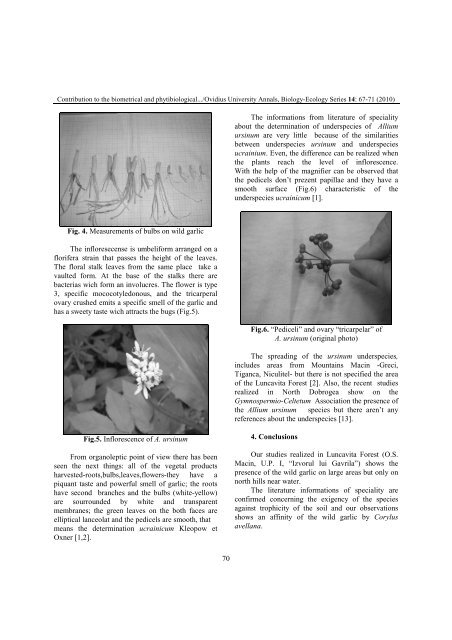VOLUM OMAGIAL - Facultatea de Ştiinţe ale Naturii şi Ştiinţe Agricole
VOLUM OMAGIAL - Facultatea de Ştiinţe ale Naturii şi Ştiinţe Agricole
VOLUM OMAGIAL - Facultatea de Ştiinţe ale Naturii şi Ştiinţe Agricole
You also want an ePaper? Increase the reach of your titles
YUMPU automatically turns print PDFs into web optimized ePapers that Google loves.
Contribution to the biometrical and phytibiological.../Ovidius University Annals, Biology-Ecology Series 14: 67-71 (2010)<br />
Fig. 4. Measurements of bulbs on wild garlic<br />
The infloresecense is umbeliform arranged on a<br />
florifera strain that passes the height of the leaves.<br />
The floral stalk leaves from the same place take a<br />
vaulted form. At the base of the stalks there are<br />
bacterias wich form an involucres. The flower is type<br />
3, specific mococotyledonous, and the tricarperal<br />
ovary crushed emits a specific smell of the garlic and<br />
has a sweety taste wich attracts the bugs (Fig.5).<br />
Fig.5. Inflorescence of A. ursinum<br />
From organoleptic point of view there has been<br />
seen the next things: all of the vegetal products<br />
harvested-roots,bulbs,leaves,flowers-they have a<br />
piquant taste and powerful smell of garlic; the roots<br />
have second branches and the bulbs (white-yellow)<br />
are sourroun<strong>de</strong>d by white and transparent<br />
membranes; the green leaves on the both faces are<br />
elliptical lanceolat and the pedicels are smooth, that<br />
means the <strong>de</strong>termination ucrainicum Kleopow et<br />
Oxner [1,2].<br />
70<br />
The informations from literature of speciality<br />
about the <strong>de</strong>termination of un<strong>de</strong>rspecies of Allium<br />
ursinum are very little because of the similarities<br />
between un<strong>de</strong>rspecies ursinum and un<strong>de</strong>rspecies<br />
ucrainium. Even, the difference can be realized when<br />
the plants reach the level of inflorescence.<br />
With the help of the magnifier can be observed that<br />
the pedicels don’t prezent papillae and they have a<br />
smooth surface (Fig.6) characteristic of the<br />
un<strong>de</strong>rspecies ucrainicum [1].<br />
Fig.6. “Pediceli” and ovary “tricarpelar” of<br />
A. ursinum (original photo)<br />
The spreading of the ursinum un<strong>de</strong>rspecies,<br />
inclu<strong>de</strong>s areas from Mountains Macin -Greci,<br />
Tiganca, Niculitel- but there is not specified the area<br />
of the Luncavita Forest [2]. Also, the recent studies<br />
realized in North Dobrogea show on the<br />
Gymnospermio-Celtetum Association the presence of<br />
the Allium ursinum species but there aren’t any<br />
references about the un<strong>de</strong>rspecies [13].<br />
4. Conclusions<br />
Our studies realized in Luncavita Forest (O.S.<br />
Macin, U.P. I, “Izvorul lui Gavrila”) shows the<br />
presence of the wild garlic on large areas but only on<br />
north hills near water.<br />
The literature informations of speciality are<br />
confirmed concerning the exigency of the species<br />
against trophicity of the soil and our observations<br />
shows an affinity of the wild garlic by Corylus<br />
avellana.





